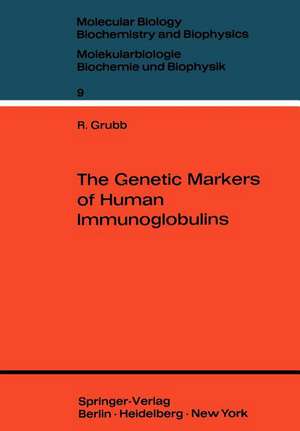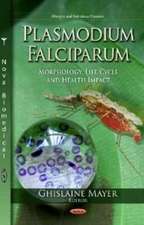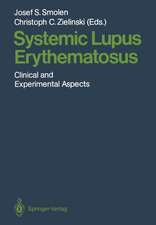The Genetic Markers of Human Immunoglobulins: Molecular Biology, Biochemistry and Biophysics Molekularbiologie, Biochemie und Biophysik, cartea 9
Autor Rune E. Grubben Limba Engleză Paperback – 23 mar 2012
Din seria Molecular Biology, Biochemistry and Biophysics Molekularbiologie, Biochemie und Biophysik
- 15%
 Preț: 627.97 lei
Preț: 627.97 lei - 15%
 Preț: 635.47 lei
Preț: 635.47 lei - 15%
 Preț: 634.82 lei
Preț: 634.82 lei - 15%
 Preț: 633.35 lei
Preț: 633.35 lei -
 Preț: 401.03 lei
Preț: 401.03 lei - 5%
 Preț: 656.53 lei
Preț: 656.53 lei - 5%
 Preț: 712.81 lei
Preț: 712.81 lei - 15%
 Preț: 648.74 lei
Preț: 648.74 lei - 5%
 Preț: 712.09 lei
Preț: 712.09 lei - 15%
 Preț: 644.63 lei
Preț: 644.63 lei - 15%
 Preț: 634.00 lei
Preț: 634.00 lei - 15%
 Preț: 641.71 lei
Preț: 641.71 lei - 15%
 Preț: 637.59 lei
Preț: 637.59 lei - 15%
 Preț: 644.82 lei
Preț: 644.82 lei - 15%
 Preț: 634.00 lei
Preț: 634.00 lei - 15%
 Preț: 650.37 lei
Preț: 650.37 lei - 15%
 Preț: 637.59 lei
Preț: 637.59 lei - 15%
 Preț: 637.13 lei
Preț: 637.13 lei - 15%
 Preț: 648.89 lei
Preț: 648.89 lei - 15%
 Preț: 632.70 lei
Preț: 632.70 lei - 15%
 Preț: 635.96 lei
Preț: 635.96 lei - 15%
 Preț: 639.41 lei
Preț: 639.41 lei - 15%
 Preț: 644.18 lei
Preț: 644.18 lei - 15%
 Preț: 654.62 lei
Preț: 654.62 lei - 15%
 Preț: 650.69 lei
Preț: 650.69 lei -
 Preț: 377.73 lei
Preț: 377.73 lei - 15%
 Preț: 634.82 lei
Preț: 634.82 lei - 15%
 Preț: 646.11 lei
Preț: 646.11 lei -
 Preț: 388.90 lei
Preț: 388.90 lei - 15%
 Preț: 640.24 lei
Preț: 640.24 lei - 15%
 Preț: 635.80 lei
Preț: 635.80 lei -
 Preț: 385.25 lei
Preț: 385.25 lei -
 Preț: 377.95 lei
Preț: 377.95 lei - 15%
 Preț: 649.39 lei
Preț: 649.39 lei
Preț: 635.47 lei
Preț vechi: 747.61 lei
-15% Nou
Puncte Express: 953
Preț estimativ în valută:
121.61€ • 126.50$ • 100.40£
121.61€ • 126.50$ • 100.40£
Carte tipărită la comandă
Livrare economică 14-28 aprilie
Preluare comenzi: 021 569.72.76
Specificații
ISBN-13: 9783642462542
ISBN-10: 3642462545
Pagini: 172
Ilustrații: XII, 154 p.
Dimensiuni: 170 x 244 x 9 mm
Greutate: 0.28 kg
Ediția:Softcover reprint of the original 1st ed. 1970
Editura: Springer Berlin, Heidelberg
Colecția Springer
Seria Molecular Biology, Biochemistry and Biophysics Molekularbiologie, Biochemie und Biophysik
Locul publicării:Berlin, Heidelberg, Germany
ISBN-10: 3642462545
Pagini: 172
Ilustrații: XII, 154 p.
Dimensiuni: 170 x 244 x 9 mm
Greutate: 0.28 kg
Ediția:Softcover reprint of the original 1st ed. 1970
Editura: Springer Berlin, Heidelberg
Colecția Springer
Seria Molecular Biology, Biochemistry and Biophysics Molekularbiologie, Biochemie und Biophysik
Locul publicării:Berlin, Heidelberg, Germany
Public țintă
ResearchCuprins
I Introduction.- Some Basic Introductory Data on Human Immunoglobulins.- II Basic Data Concerning Genetic Human Immunoglobulin Markers.- Techniques.- Nomenclature.- Introductory Survey of Main Genetic Ig Factors.- III Interpretation of Immunological Concepts and of Notational Terms in Structural Concepts.- Chemical Correlate of Descriptive Terms.- Some Pitfalls in the Interpretation of Statistics of Immunologic Findings in Terms of Chemical Structure, as Elucidated by Studies of the Gm System. Degree of Complexity.- IV The Formal Genetics of the Gm and Inv Systems.- Lack of Evidence for Excessive Mutability within the Gm and Inv Systems.- Linkage Relations between the Gm System and Other Polymorphic Systems, in Particular Inv.- Associations between Particular Gm Factors Due to the Presence of Determinants on the Same H-Polypeptide Chain. The Distribution of Gm Factors among the IgG Molecules within a Given Individual.- Associations between Particular Gm Factors Observed in Segregation Studies in Families.- The Gm Chromosome Segment as a Compound of Several Loci, Each Related to an IgG Subclass.- The Question of Crossing Over between IgG Loci.- “Gm-” Alleles and Their Interpretation.- Evaluation.- The Formal Genetics of the Inv System.- V Human Anti-Human-Gammaglobulins, Their Specificity and Function. Genetic Ig Factors and Tolerance.- Categories of Human Anti-Human-Ig.- The Concept of Allosteric Change as Applied to Immunologic Reactions, in Particular to the Anti-Antibody of Milgrom Type.- The Appearance of Anti-Gm’s in Early Extrauterine Life. Genetic Ig Factors and Tolerance.- Physiological and Pathophysiological Roles of Anti-Gamma-globulins.- VI Immunoglobulin Polymorphism as an Example of Molecular Differentiation in Macroorganisms. Mutual AllelicExclusion.- Phylogeny of Immunoglobulin Polymorphism.- Variation in Ig Polymorphism with Ethnic Group.- Ontogeny of Immunoglobulin Polymorphism.- Ig Genetic Factors During Antigenic Stimulation.- Ig Genetic Factors in Various Body Compartments.- Relation of Ig Genetic Factors of Mother and Child at Birth.- Regional Differentiation within the Immunoglobulin-Producing Cell Population. Allelic Exclusion.- Application in Forensic Medicine.- VII Selection and Control of Immunoglobulin Structure.- Levels of Genetic Control of the Immune Response.- Regulation of Ig Structure. Levels of Control.- Models for Allelic Exclusion in Ig Production.- The Non-Random Character of Partner Chain Selection.- Clonal Regulation in the Macroorganism.- Ig Structure Related to Antibody Properties Other than Antigen-Binding. Evolutionary Aspects.- Appendix Compilation of Data Concerning Genetic Factors of Human Immunoglobulins.- Gm(l).- Gm(2).- Gm(3).- Gm(4).- Gm(5).- Gm(6).- Gm(7).- Gm(8).- Gm(9).- Gm(10).- Gm(ll).- Gm(12).- Gm(13).- Gm(14).- Gm(15).- Gm(16).- Gm(17).- Gm(18).- Gm(19).- Gm(20).- Gm(21).- Gm(22).- Gm(23).- Gm(m).- Inv(l).- Inv(2).- Inv(3).- Isf(l).- Am.- Miscellaneous Factors, Hitherto not Properly Defined, but Possibly Related to the Gm System.- References.










